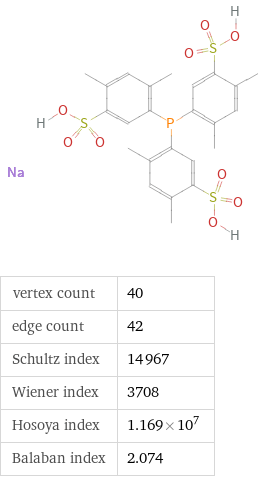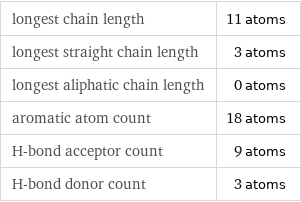Input interpretation

tris(2, 4-dimethyl-5-sulfophenyl)phosphine trisodium salt
Basic properties
![molar mass | 655.6 g/mol formula | C_24H_27Na_3O_9PS_3 empirical formula | Na_3C_24S_3O_9P_H_27 SMILES identifier | CC1=CC(=C(C=C1P(C2=CC(=C(C)C=C2C)S(=O)(=O)O)C3=CC(=C(C)C=C3C)S(=O)(=O)O)S(=O)(=O)O)C.[Na].[Na].[Na] InChI identifier | InChI=1/C24H27O9PS3.3Na/c1-13-7-16(4)22(35(25, 26)27)10-19(13)34(20-11-23(36(28, 29)30)17(5)8-14(20)2)21-12-24(37(31, 32)33)18(6)9-15(21)3;;;/h7-12H, 1-6H3, (H, 25, 26, 27)(H, 28, 29, 30)(H, 31, 32, 33);;;/f/h25, 28, 31H;;; InChI key | JJQXQIWNZAIKKM-UHFFFAOYSA-N](../image_source/9c916327fffdcc5479ed8e58ba6fb90d.png)
molar mass | 655.6 g/mol formula | C_24H_27Na_3O_9PS_3 empirical formula | Na_3C_24S_3O_9P_H_27 SMILES identifier | CC1=CC(=C(C=C1P(C2=CC(=C(C)C=C2C)S(=O)(=O)O)C3=CC(=C(C)C=C3C)S(=O)(=O)O)S(=O)(=O)O)C.[Na].[Na].[Na] InChI identifier | InChI=1/C24H27O9PS3.3Na/c1-13-7-16(4)22(35(25, 26)27)10-19(13)34(20-11-23(36(28, 29)30)17(5)8-14(20)2)21-12-24(37(31, 32)33)18(6)9-15(21)3;;;/h7-12H, 1-6H3, (H, 25, 26, 27)(H, 28, 29, 30)(H, 31, 32, 33);;;/f/h25, 28, 31H;;; InChI key | JJQXQIWNZAIKKM-UHFFFAOYSA-N
Structure diagram

vertex count | 40 edge count | 42 Schultz index | 14967 Wiener index | 3708 Hosoya index | 1.169×10^7 Balaban index | 2.074
Quantitative molecular descriptors

longest chain length | 11 atoms longest straight chain length | 3 atoms longest aliphatic chain length | 0 atoms aromatic atom count | 18 atoms H-bond acceptor count | 9 atoms H-bond donor count | 3 atoms
Elemental composition

Find the elemental composition for tris(2, 4-dimethyl-5-sulfophenyl)phosphine trisodium salt in terms of the atom and mass percents: atom percent = N_i/N_atoms × 100% mass percent = (N_im_i)/m × 100% Plan: • Write the chemical formula and gather atomic masses from the periodic table. • Determine values for N_i, m_i, N_atoms and m using these items. • Finally, compute the percents and check the results. Write the chemical formula: C_24H_27Na_3O_9PS_3 Use the chemical formula to count the number of atoms, N_i, for each element and find the total number of atoms, N_atoms, per molecule: | number of atoms Na (sodium) | 3 C (carbon) | 24 S (sulfur) | 3 O (oxygen) | 9 P (phosphorus) | 1 H (hydrogen) | 27 N_atoms = 3 + 24 + 3 + 9 + 1 + 27 = 67 Divide each N_i by N_atoms to calculate atom fractions. Then use the property that atom fractions must sum to one to check the work: | number of atoms | atom fraction Na (sodium) | 3 | 3/67 C (carbon) | 24 | 24/67 S (sulfur) | 3 | 3/67 O (oxygen) | 9 | 9/67 P (phosphorus) | 1 | 1/67 H (hydrogen) | 27 | 27/67 Check: 3/67 + 24/67 + 3/67 + 9/67 + 1/67 + 27/67 = 1 Compute atom percents using the atom fractions: | number of atoms | atom percent Na (sodium) | 3 | 3/67 × 100% = 4.48% C (carbon) | 24 | 24/67 × 100% = 35.8% S (sulfur) | 3 | 3/67 × 100% = 4.48% O (oxygen) | 9 | 9/67 × 100% = 13.4% P (phosphorus) | 1 | 1/67 × 100% = 1.49% H (hydrogen) | 27 | 27/67 × 100% = 40.3% Look up the atomic mass, m_i, in unified atomic mass units, u, for each element in the periodic table: | number of atoms | atom percent | atomic mass/u Na (sodium) | 3 | 4.48% | 22.98976928 C (carbon) | 24 | 35.8% | 12.011 S (sulfur) | 3 | 4.48% | 32.06 O (oxygen) | 9 | 13.4% | 15.999 P (phosphorus) | 1 | 1.49% | 30.973761998 H (hydrogen) | 27 | 40.3% | 1.008 Multiply N_i by m_i to compute the mass for each element. Then sum those values to compute the molecular mass, m: | number of atoms | atom percent | atomic mass/u | mass/u Na (sodium) | 3 | 4.48% | 22.98976928 | 3 × 22.98976928 = 68.96930784 C (carbon) | 24 | 35.8% | 12.011 | 24 × 12.011 = 288.264 S (sulfur) | 3 | 4.48% | 32.06 | 3 × 32.06 = 96.18 O (oxygen) | 9 | 13.4% | 15.999 | 9 × 15.999 = 143.991 P (phosphorus) | 1 | 1.49% | 30.973761998 | 1 × 30.973761998 = 30.973761998 H (hydrogen) | 27 | 40.3% | 1.008 | 27 × 1.008 = 27.216 m = 68.96930784 u + 288.264 u + 96.18 u + 143.991 u + 30.973761998 u + 27.216 u = 655.594069838 u Divide the mass for each element by m to calculate mass fractions. Then use the property that mass fractions must sum to one to check the work: | number of atoms | atom percent | mass fraction Na (sodium) | 3 | 4.48% | 68.96930784/655.594069838 C (carbon) | 24 | 35.8% | 288.264/655.594069838 S (sulfur) | 3 | 4.48% | 96.18/655.594069838 O (oxygen) | 9 | 13.4% | 143.991/655.594069838 P (phosphorus) | 1 | 1.49% | 30.973761998/655.594069838 H (hydrogen) | 27 | 40.3% | 27.216/655.594069838 Check: 68.96930784/655.594069838 + 288.264/655.594069838 + 96.18/655.594069838 + 143.991/655.594069838 + 30.973761998/655.594069838 + 27.216/655.594069838 = 1 Compute mass percents using the mass fractions: Answer: | | | number of atoms | atom percent | mass percent Na (sodium) | 3 | 4.48% | 68.96930784/655.594069838 × 100% = 10.52% C (carbon) | 24 | 35.8% | 288.264/655.594069838 × 100% = 43.97% S (sulfur) | 3 | 4.48% | 96.18/655.594069838 × 100% = 14.67% O (oxygen) | 9 | 13.4% | 143.991/655.594069838 × 100% = 21.96% P (phosphorus) | 1 | 1.49% | 30.973761998/655.594069838 × 100% = 4.725% H (hydrogen) | 27 | 40.3% | 27.216/655.594069838 × 100% = 4.151%
Elemental oxidation states

The first step in finding the oxidation states (or oxidation numbers) in tris(2, 4-dimethyl-5-sulfophenyl)phosphine trisodium salt is to draw the structure diagram. Next set every oxidation number equal to the atom's formal charge: In tris(2, 4-dimethyl-5-sulfophenyl)phosphine trisodium salt hydrogen is not bonded to a metal with lower electronegativity, so it will have an oxidation state of +1. Any element bonded to hydrogen gains the bonding electrons, decreasing their oxidation state by 1 for every bond: With hydrogen out of the way, look at the remaining bonds. There are 3 carbon-phosphorus bonds, 3 carbon-sulfur bonds, 9 oxygen-sulfur bonds, and 24 carbon-carbon bonds. For each of these bonds, assign the bonding electrons to the most electronegative element. First examine the carbon-phosphorus bonds: element | electronegativity (Pauling scale) | C | 2.55 | P | 2.19 | | | Since carbon is more electronegative than phosphorus, the electrons in these bonds will go to carbon. Decrease the oxidation number for carbon in every highlighted bond (by 1 for single bonds, 2 for double bonds, and 3 for triple bonds), and increase the oxidation number for phosphorus accordingly: Next look at the carbon-sulfur bonds: element | electronegativity (Pauling scale) | C | 2.55 | S | 2.58 | | | Since sulfur is more electronegative than carbon, the electrons in these bonds will go to sulfur: Next look at the oxygen-sulfur bonds: element | electronegativity (Pauling scale) | O | 3.44 | S | 2.58 | | | Since oxygen is more electronegative than sulfur, the electrons in these bonds will go to oxygen: Next look at the carbon-carbon bonds: element | electronegativity (Pauling scale) | C | 2.55 | C | 2.55 | | | Since these elements are the same the bonding electrons are shared equally, and there is no change to the oxidation states: Now summarize the results: Answer: | | oxidation state | element | count -3 | C (carbon) | 6 -2 | O (oxygen) | 9 -1 | C (carbon) | 9 0 | C (carbon) | 6 | Na (sodium) | 3 +1 | C (carbon) | 3 | H (hydrogen) | 27 +3 | P (phosphorus) | 1 +4 | S (sulfur) | 3
Topological indices

vertex count | 67 edge count | 66 Schultz index | 52062 Wiener index | 13335 Hosoya index | (data not available) Balaban index | 2.865